2003 PONTIAC BONNEVILLE octane
[x] Cancel search: octanePage 163 of 418
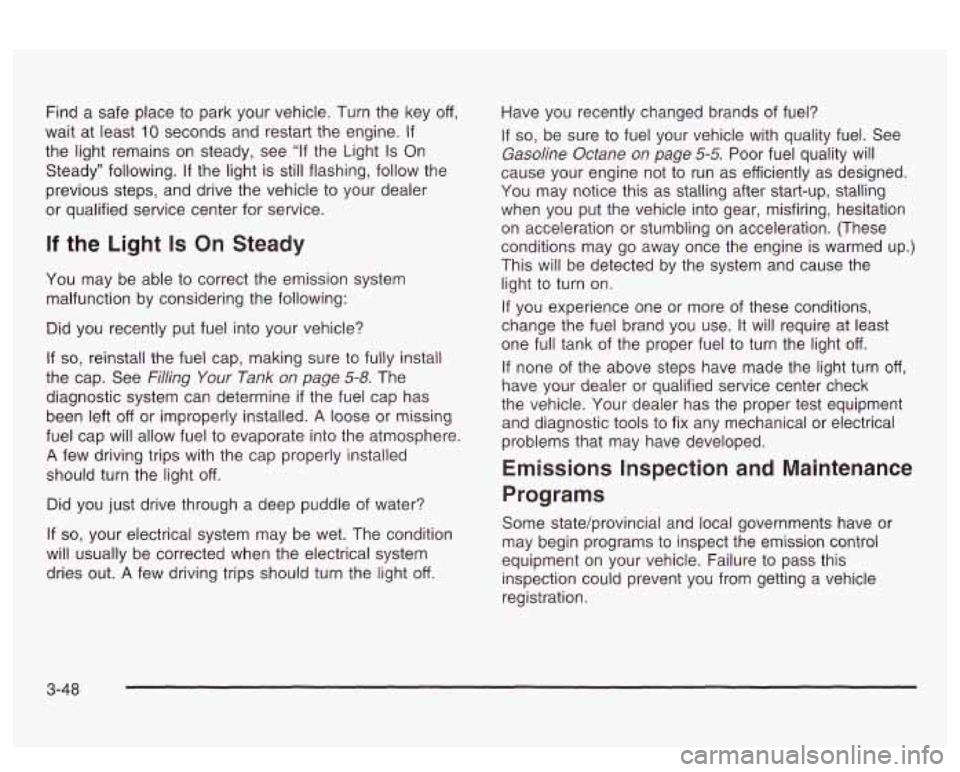
Find a safe place to park your vehicle. Turn the key off,
wait at least
10 seconds and restart the engine. If
the light remains on steady, see “If the Light Is On
Steady” following.
If the light is still flashing, follow the
previous steps, and drive the vehicle to your dealer
or qualified service center for service.
If the Light Is On Steady
You may be able to correct the emission system
malfunction by considering the following:
Did you recently put fuel into your vehicle?
If so, reinstall the fuel cap, making sure to fully install
the cap. See
Filling Your Tank on page 5-8. The
diagnostic system can determine
if the fuel cap has
been left
off or improperly installed. A loose or missing
fuel cap will allow fuel to evaporate into the atmosphere.
A few driving trips with the cap properly installed
should turn the light off.
Did you just drive through a deep puddle of water?
If so, your electrical system may be wet. The condition
will usually be corrected when the electrical system
dries out.
A few driving trips should turn the light off.
Have you recently changed brands of fuel?
If so, be sure to fuel your vehicle with quality fuel. See
Gasoline Octane on page 5-5. Poor fuel quality will
cause your engine not to run as efficiently as designed.
You may notice this as stalling after start-up, stalling
when you put the vehicle into gear, misfiring, hesitation
on acceleration or stumbling on acceleration. (These
conditions may go away once the engine is warmed up.)
This will be detected by the system and cause the
light to turn on.
If you experience one or more of these conditions,
change the fuel brand you use. It will require at least
one full tank of the proper fuel to turn the light off.
If none of the above steps have made the light turn
off,
have your dealer or qualified service center check
the vehicle. Your dealer has the proper test equipment
and diagnostic tools to fix any mechanical or electrical
problems that may have developed.
Emissions Inspection and Maintenance
Programs
Some state/provincial and local governments have or
may begin programs to inspect the emission control
equipment on your vehicle. Failure to pass this
inspection could prevent you from getting a vehicle
registration.
3-48
Page 260 of 418
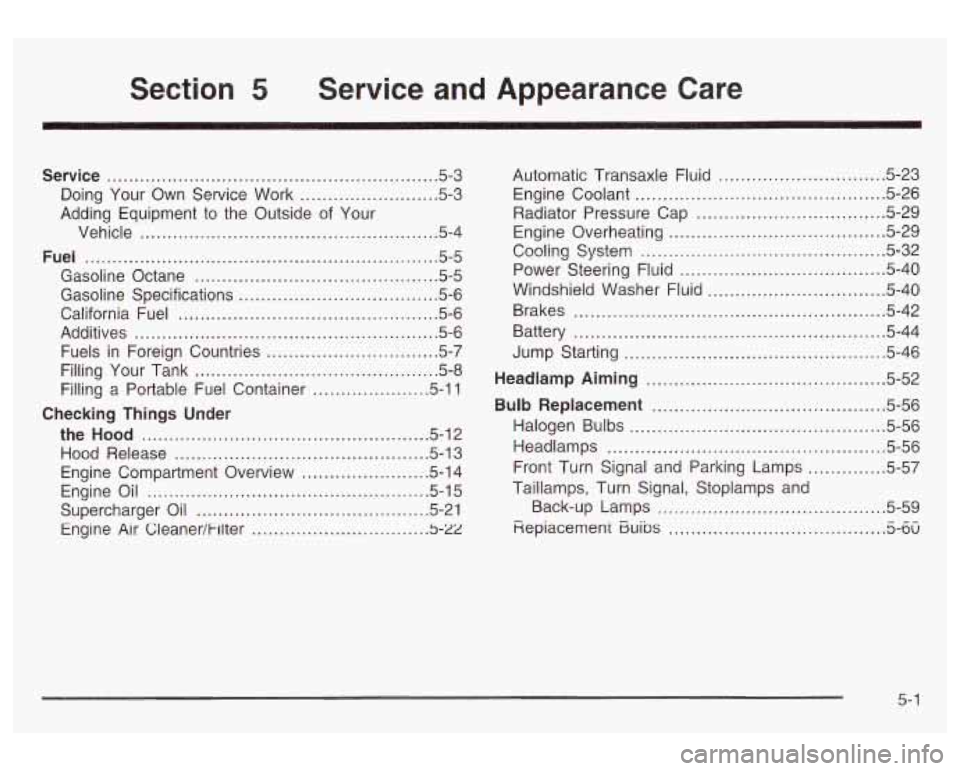
Section 5 Service and Appearance Care
Service ........................................................ 5.3
Doing Your Own Service Work
......................... 5.3
Adding Equipment to the Outside
of Your
Vehicle
...................................................... 5.4
Fuel ................................................................ 5.5
Gasoline Octane
............................................ 5.5
Gasoline Specifications
.................................... 5.6
California Fuel
............................................... 5.6
Additives
....................................................... 5.6
Fuels in Foreign Countries
............................ 5.7
Filling Your Tank
........................... .......... 5.8
Filling
a Portable Fuel Container ..... .... 5.11
the Hood ............................. .... 5.12
Hood Release
.............................. ........ 5.13
Engine Compartment Overview ...................... -5-1 4
Checking Things Under
Engine Oil ................................................... 5.15
Supercharger Oil .......................................... 5.21
Engine Air Cleaner/t-llter
................................ 5-22
Automatic Transaxle Fluid .............................. 5.23
Engine Coolant
............................................. 5.26
Radiator Pressure Cap
.................................. 5.29
Engine Overheating
....................................... 5.29
Cooling System
............................................ 5.32
Power Steering Fluid
..................................... 5.40
Windshield Washer Fluid
................................ 5.40
Brakes
........................................................ 5.42
Battery
........................................................ 5-44
Jump Starting
............................................... 5-46
Headlamp Aiming .......................... ...... 5.52
Bulb Replacement .................................. -5-56
Halogen Bulbs
.............................................. 5.56
Headlamps
.................................................. 5.56
Front Turn Signal and Parking Lamps
.............. 5-57
Taillamps, Turn Signal, Stoplamps and
Back-up Lamps
......................................... 5-59
fiepiacement
Euibs 3.w - ^^ .......................................
5- I
Page 264 of 418
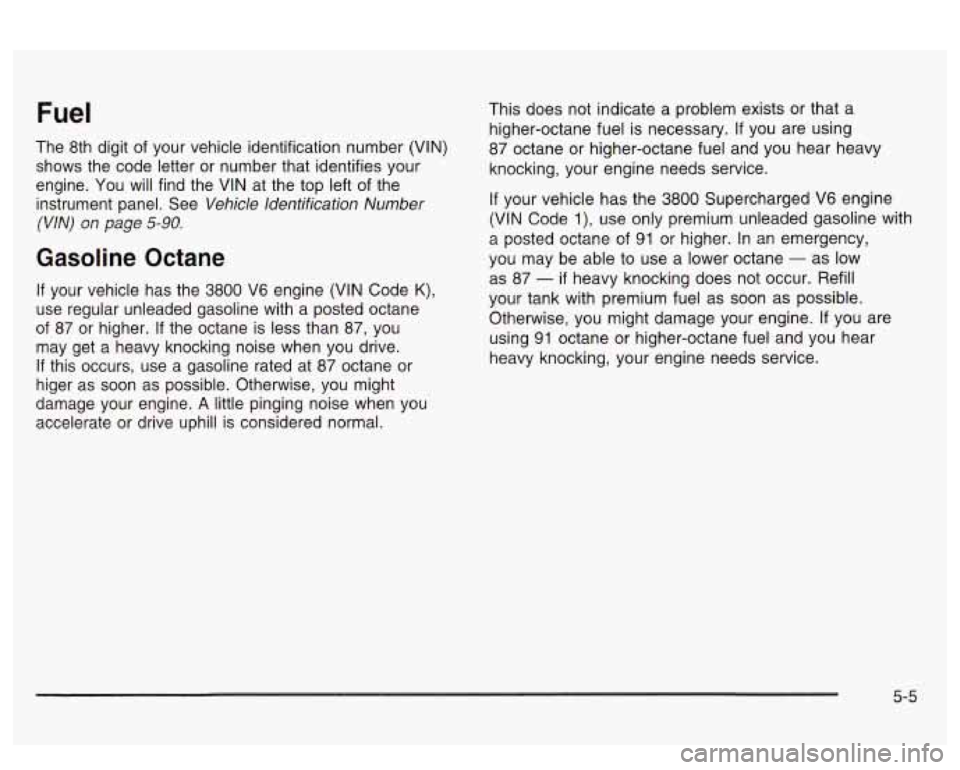
Fuel
The 8th digit of your vehicle identification number (VIN)
shows the code letter or number that identifies your
engine. You will find the VIN at the top left of the
instrument panel. See
Vehicle ldentification Number
(VIN) on page
5-90.
Gasoline Octane
If your vehicle has the 3800 V6 engine (VIN Code K),
use regular unleaded gasoline with a posted octane
of 87 or higher. If the octane is less than 87, you
may get a heavy knocking noise when you drive.
If this occurs, use a gasoline rated at 87 octane or
higer as
soon as possible. Otherwise, you might
damage your engine.
A little pinging noise when you
accelerate or drive uphill is considered normal. This does not
indicate a problem exists or that a
higher-octane fuel is necessary.
If you are using
87 octane or higher-octane fuel and you hear heavy
knocking, your engine needs service.
If your vehicle has the 3800 Supercharged V6 engine
(VIN Code
I), use only premium unleaded gasoline with
a posted octane of
91 or higher. In an emergency,
you may be able to use a lower octane
- as low
as 87
- if heavy knocking does not occur. Refill
your tank with premium fuel as soon as possible.
Otherwise, you might damage your engine.
If you are
using
91 octane or higher-octane fuel and you hear
heavy knocking, your engine needs service.
5-5
Page 266 of 418

Notice: Your vehicle was not designed for fuel that
contains methanol. Don’t use fuel containing
methanol. It can corrode metal parts in your fuel
system and also damage the plastic and rubber
parts. That damage wouldn’t be covered under your
warranty.
Some gasolines that are not reformulated for low
emissions may contain an octane-enhancing additive
called methylcyclopentadienyl manganese tricarbonyl
(MMT); ask the attendant where you buy gasoline
whether the fuel contains MMT. General Motors does
not recommend the use of such gasolines. Fuels
containing MMT can reduce the life of spark plugs and
the performance of the emission control system may
be affected. The malfunction indicator
lamp may turn on.
If this occurs, return to your authorized GM dealer for
service.
Fuels in Foreign Countries
If you plan on driving in another country outside the
United States or Canada, the proper fuel may be hard
to find. Never use leaded gasoline or any other fuel
not recommended in the previous text on fuel. Costly
repairs caused by use of improper fuel wouldn’t be
covered by your warranty.
To check the fuel availability, ask an auto club, or
contact a major oil company that does business in the
country where you’ll be driving.
5-7
Page 365 of 418
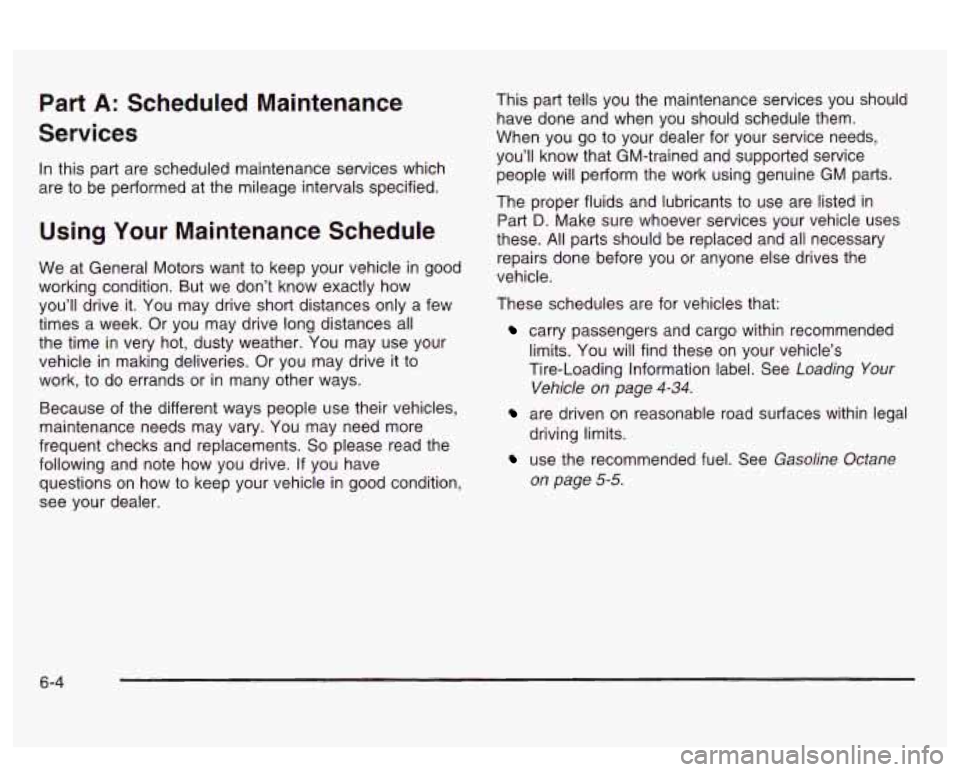
Part A: Scheduled Maintenance
Services
In this part are scheduled maintenance services which
are to be performed at the mileage intervals specified.
Using Your Maintenance Schedule
We at General Motors want to keep your vehicle in good
working condition. But we don’t know exactly how
you’ll drive it. You may drive short distances only a few
times a week. Or you may drive long distances all
the time in very hot, dusty weather. You may use your
vehicle in making deliveries. Or you may drive it to
work, to do errands or in many other ways.
Because of the different ways people use their vehicles,
maintenance needs may vary. You may need more
frequent checks and replacements. So please read the
following and note how you drive.
If you have
questions on how to keep your vehicle in good condition,
see your dealer. This part tells you the
maintenance services you should
have done and when you should schedule them.
When you go to your dealer for your service needs,
you’ll know that GM-trained and supported service
people will perform the work using genuine GM parts.
The proper fluids and lubricants to use are listed in
Part
D. Make sure whoever services your vehicle uses
these.
All parts should be replaced and all necessary
repairs done before you or anyone else drives the
vehicle.
These schedules are for vehicles that:
carry passengers and cargo within recommended
limits. You will find these on your vehicle’s
Tire-Loading Information label. See
Loading Your
Vehicle on page 4-34.
are driven on reasonable road surfaces within legal
use the recommended fuel. See Gasoline Octane
driving limits.
on page 5-5.
6-4
Page 405 of 418
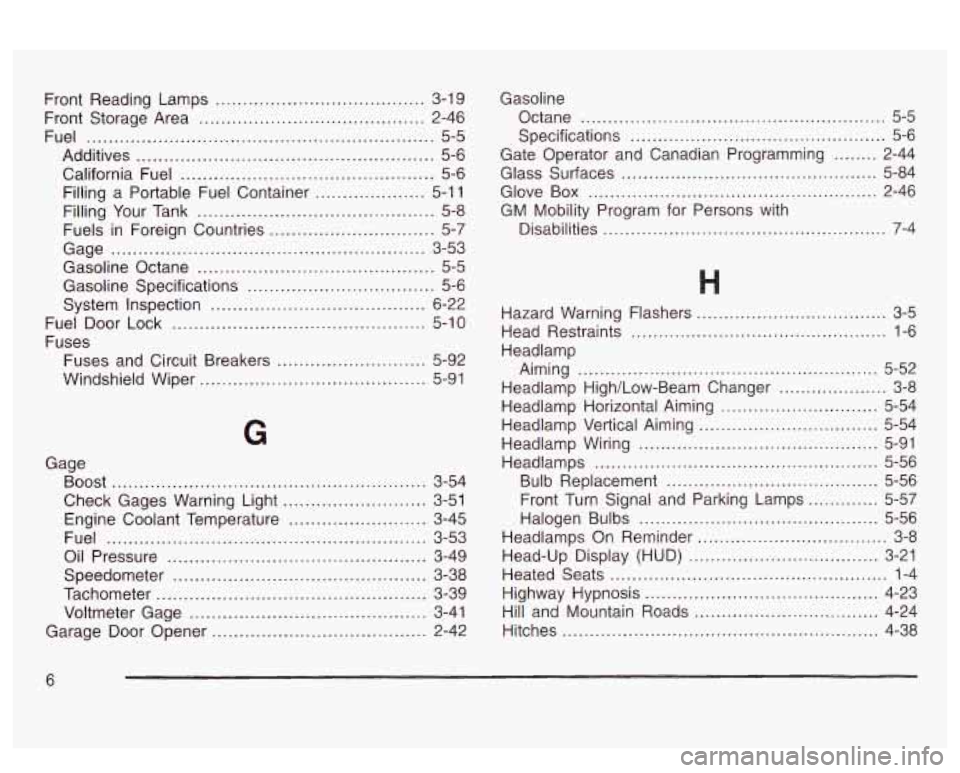
Front Reading Lamps ...................................... 3-19
Front Storage Area
......................................... 2-46
Fuel
............................................................... 5-5
Additives ...................................................... 5-6
California Fuel
.............................................. 5-6
Filling a Portable Fuel Container
.................... 5-1 1
Filling Your Tank
........................................... 5-8
Fuels in Foreign Countries
.............................. 5-7
Gage ......................................................... 3-53
Gasoline Octane
........................................... 5-5
Gasoline Specifications .................................. 5-6
System Inspection
....................................... 6-22
Fuel Door Lock
.............................................. 5-10
Fuses Fuses and Circuit Breakers
........................... 5-92
Windshield Wiper
......................................... 5-91
G
Gage Boost
......................................................... 3-54
Check Gages Warning Light
.......................... 3-51
Engine Coolant Temperature
......................... 3-45
Fuel
.......................................................... 3-53
Oil Pressure
............................................... 3-49
Speedometer
.............................................. 3-38
Tachometer
................................................. 3-39
Voltmeter Gage
........................................... 3-41
Garage
Door Opener ....................................... 2-42 Gasoline
Octane
........................................................ 5-5
Specifications ............................................... 5-6
Gate Operator and Canadian Programming
........ 2-44
Glass Surfaces
............................................... 5-84
Glove
Box ..................................................... 2-46
GM Mobility Program for Persons with
Disabilities
................................................ 7-4
Hazard Warning Flashers ................................... 3-5
Head Restraints
............................................... 1-6
Headlamp Aiming
....................................................... 5-52
Headlamp High/Low-Beam Changer .................... 3-8
Headlamp Horizontal Aiming
............................. 5-54
Headlamp Vertical Aiming
................................. 5-54
Headlamp Wiring
............................................ 5-91
Headlamps
.................................................... 5-56
Bulb Replacement
....................................... 5-56
Front Turn Signal and Parking Lamps
............. 5-57
Halogen Bulbs ............................................ 5-56
Headlamps On Reminder
................................... 3-8
Head-Up Display (HUD)
................................... 3-21
Heated Seats
................................................... 1-4
Highway Hypnosis
........................................... 4-23
Hill and Mountain Roads
.................................. 4-24
Hitches
.......................................................... 4-38
6